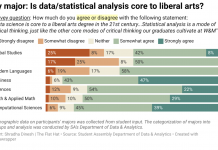Some things haven’t changed since 1693. At the College of William and Mary, the distinction between earning grades and receiving them has always been clear, and while grade inflation is a concern in much of the academic world, most students and faculty don’t see it as much of an issue at the College.
“At some points I’ve personally felt grade inflation, but I feel less of it here at William and Mary,” Asha Williams ’12 said.
Grade inflation, according to history professor Cindy Hahamovitch, is the practice of “giving students high grades, not because they merit them, but to avoid conflict or disappointment.” According to a recent study by former Duke University professor Stuart Rojstaczer and Furman University professor Christopher Healy, the phenomenon has been on the rise since the 1960s.
In 1960, approximately 15 percent of grades awarded at universities were A’s; in 2008, A’s accounted for 43 percent of grades given. For the 1991-1992 academic year, the average GPA at all universities was 2.93; for 2006-2007, the average was 3.11.
The phenomenon seems to be more prevalent at private schools, where almost half of the grades awarded in 2007 were A’s. The percentage of A’s was around 40 percent at public schools in the same year.
At the College, grade distribution percentages have remained consistent for the past five years, but cumulative GPA records indicate that students have slightly higher grades now than they did a few years ago.
The average undergraduate cumulative GPA in fall 2005 was 3.20, whereas the average in fall 2009 was 3.25.
In comparison, the average cumulative GPA in spring 2008 at the University of Virginia was 3.22, while the average cumulative GPA in fall 2008 at the College was 3.25.
Despite these creeping numbers, students and professors do not seem to have felt the effects of grade inflation at the College. One reason for this may be the culture of hard work on campus.
“We have a student body full of high achievers who are determined to have a good GPA, and they work for it,” Taylor Gaukel ’14 said.
Professor Marylou Zapf, who has taught at the College for a decade, believes the quality of students has always been high and is even on the rise. Fewer students ask about extra credit, and more students are interested in gaining knowledge, she said.
Student satisfaction with grading at the College may stem in part from the fact that most professors do not limit the number of students who can earn a high grade.
“If they all do well, they all do well, and vice-versa,” history professor Jody Allen said. “I give them a clear direction to what I’m looking for, and I’m looking for how well they complete the assignment.”
Professors’ approachability and accessibility may also be contributing factors.
“If they mark something down as wrong, and I talk to them about why I think it isn’t wrong, they’re willing to understand my reasoning,” Brittany Strimple ’13 said.
Encouraging students to treat their classes as learning opportunities rather than just GPA-boosters may decrease the pressure they feel to get straight A’s and the pressure professors feel to award them.
“Everything is geared toward passing exams, and it shouldn’t be that way,” chemistry professor Carey Bagdassarian said. “Students here learn how to think and play intellectually.”
Rather than identifying the school as suffering from grade inflation, students expressed satisfaction with the level of difficulty of their classes.
“I like this system because it makes it a bit more challenging to get the grade we really want while giving us a little net by making it harder to get a grade we don’t want,” Humzah Nasir ’14 said.

































